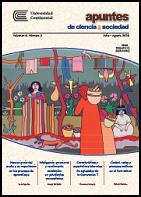Neurolearning: New proposals in university education
Abstract
In recent years, the vertiginous changes in all areas of human knowledge have modified the socioeconomic, political and educational structure; what forces to make use of new contributions, research products in different areas. In Education there is new information provided, both neuroscience and psychology, which led to “neurolearning”. This documentary review is aimed at providing information on some topics that the teacher should consider during the teachinglearning process, such as: the role of the cerebral lobes, neurotransmitters, sleep, nutrition and neurolinguistic programming ( NLP); but how should they be incorporated in the classrooms? simply, taking into account some recommendations: have enriched environments, stimulate multisensorially, carry out collaborative work, consider prior knowledge, learn by doing, employ at all times the generation of learning by asking questions and maintaining attention, for this you must make use of the efficient communication; and most importantly, to conserve at all times happiness and passion for what is done. The objective is to raise awareness about the importance of applying the latest contributions of neuro-learning in university students. For this, different documents were reviewed, although not in a profound way, but enough to encourage teachers to seek more information.
References
Aamondt, & Wang. (2009). Bienvenido al cerebro del niño. Dinamarca: Norhaven.
Battro. (2011). Neuroeducación: el cerebro en la escuela. Sigman. Obtenido de http://www.mbe-erice.org/papers/2014-battro-ciclosneuroeducacion.pdf
Bauer. (2013). Asociación de la violencia con la depresión. Pediatría, 1-7.
Braidot. (2009). Instituto Braidot. Obtenido de https://braidot.com/tag/sistema-nervioso/
Caicedo, H. (2012). neuroaprendizaje, una propuesta educativa. Bogotá: Ediciones de la U.
Carretié, L. (2016). Anatomía de la mente. Madrid: Pirámide.
CERI. (2009). La comprensión del cerebro, el nacimiento de una ciencia del aprendizaje. Santiago: UCSH.
Gazzaniga. (1996). Conversaciones sobre neurociencia cognitiva. Cambridge: MIT.
Izaguirre. (2015). Neuroproceso de la enseñanza y del aprendizaje. Lima: Tarea Asociación Gráfica Educativa.
Leiva, M. (2010). Neurotransmisores Primeros y segundos mensajeros. Guatemala: Universidad de San Carlos de Guatemala.
Lipina, S., & Sigman, M. (2011). La pizarra de Babel: puentes entre neurociencia, psicología y educación. Buenos Aires: Libros del Zorzal.
Mora, F. (2005). Neuroeducación. Argentina: Alianza Editorial.
Tirapu. (2005). Memoria y funciones ejecutivas. Revista de Neuropsicología, 41.
Tokuhama-Espinosa (2014). Aprendizaje. En http://thelearningsciences.com/site/?lang=en.Conexiones













